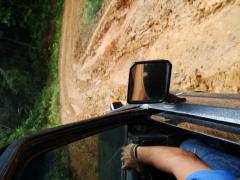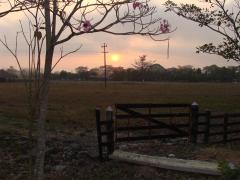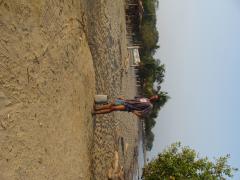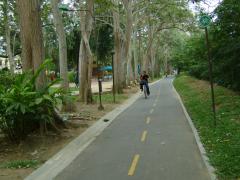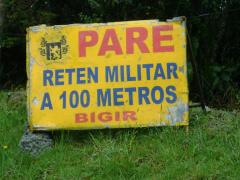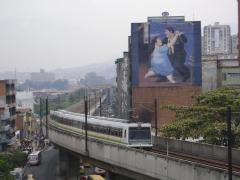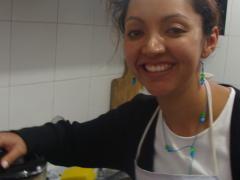Inuvik to Ushuaia
Panama to Cartagena, Colombia
Here is the story of our trip from Panama City to Cartagena, Columbia – starting in a 4x4 vehicle from Panama City to Carti, Panama and then taking the 100´ sailboat the Stahlratte to Cartagena.
We got picked up at at the Hotel California in Panama City at 5:15 in the morning and threw our bikes and gear up on the roof rack and squeezed in the back with 7 other passengers, all who were going on the same sailing trip from Panama to Columbia. I, more than Randy, thought it would be great fun to take a long sailing trip. I have always thought I should try it to see if I might want to sail around the world after I finish biking half way around the world.
As we rode in the back of the jeep I was very grateful to be in the truck and not trying to ride, push or throw my bike along this route. The road was flat at first and paved until the turn off at El Llano, but that’s where the real road started. Other cyclists before us have ridden this and described this section as having 100 hills and many 20% grades. It was very impressive and I think I would have died trying to ride it. It had been raining the night before and the rain carved eroded mud-lined tracks that zigzag down the steepest parts. The truck would slide from side to side trying to find a hold in the red mush we sloshed through. Other trucks ahead and behind us also had moments of uncontrolled maneuvering. One 4x4 vehicle we passed parked at the creast of a hill was overheating from the taxing travels through the Kuna jungle. After we arrived at the end of the road, a trip which took about 4 hours, I was very happy with our decision not to have ridden this ride. Our newly cleaned bikes appreciated it too. read more here... lee mas aquí... »
Riding the lowlands of Colombia
If Columbia has always been a mystery to you as it has been to me let me give you a brief impression of our 3 day out ride. (yes, Nancy can be brief once in awhile)
Southwest of Cartagena along the coastal roads, it is the land of grazing hotland cows that are shiny gray and look like water buffaloes. The land is mostly dry and more dry with some huge trees spread out across the flatlands. Mostly is hot, hot and hotter. The temperature read 112 degrees fahrenheit as we rode (that was with the thermometer in the sun). The night cooled down to 86 degrees at 10:00 at night. Two hours after sunrise and two hours before sunset the sky is on fire with orange hazy humidity. The roads are great to ride, because on our backroads route there are more cyclists than cars, and many motorcycles, and a few buses, who all work well together sharing the highways and byways equally. It belongs to everyone. What a unique feeling to ride without the fear of being squashed. So far, we've had lots of respect from all motorized traffic. (We get back to the main highway in a couple of days. Hope our report is the same.) And people call us amigos instead of gringos. read more here... lee mas aquí... »
A Wonderful Rest Day in a Beautiful Place
Montería, Córdoba, Colombia, is a town a cyclist might miss or any other tourist might just drive by it because it is off the main road by quite a few kilometers. If you ever come this way, do come and spend a day or two. We are amazed at the street after street of vendors and the most amazing riverside park we have seen in our travel of the Americas.
Situated along the Sinú river is a town that could be any town in Colombia but it is not because of the incredible riverside park. The park, built 5 years ago, is the shining gem of the town. There are brick lined walkways for pedestrians, a bike path with striped lanes, an art museum, a small amphitheater for practicing plays and breakdancing tricks like spinning on the head. There's an internet cafe for coffee and for writing this story, exotic plants, huge trees with monkeys, a wonderful playground with attendants to take care of the children, a adult playground for stretching and doing strength training, ice cream shops, haircutting stands (yes, right in the park). All of this was designed by some extraordinary designers who turned this riverside property into a world-class site for all to enjoy. The best part it is a public park and absolutely free. The town has invested a lot of resources into this public space and is continuing to expand into the rather raunchy street side fish market vendors. read more here... lee mas aquí... »
Politics and Security in Colombia
You´ve all heard of Colombia and the tremendous security/drug/paramilitary/guerrilla problems they´ve had over the years. Some of you told us not to go here because of what you had heard. We decided to go, however, because of what we heard from the cyclists who had actually passed through: it´s a calm country, beautiful, with incredibly friendly people. And that´s what we´re finding too. We haven´t had any problem, but we do read the paper and we do see the results of the strain they´ve had over the years.
Basically, Colombia got buried under the corruption of drugs and the challenge of a revolutionary insurgency for decades. They seem to be digging their way out over the last ten years or so, and the current president, Alvaro Uribe, is immensely popular for the progress he´s made. The guerrilla group, the FARC, is still there and still holds some very important hostages, some that it's had for more than 8 years. But it seems to be declining in power and influence. You might wonder from reading the paper that their primary reason to keep holding those hostages is that it's their last grasp on power. The FARC seems to be still quite dependent on the drug trade for its financing.
During the guerrilla years, private security forces were created by the big landowners, and developed into what's called "paramilitary forces" here. Essentially, they became private armies in their own right. read more here... lee mas aquí... »
Medellin, Colombia - A Young City
Hours of walking the streets of Medellín, Colombia gives me a true sampling of the culture of this cosmopolitan city. Medellin is the capital of Antioquia and home to 3 million people. The city is the center for culture, health, government, education and art. All of this is wrapped up together creating a diverse and interesting experience. Situated in the middle of the Columbian Andes, the city has grown out of the valleys and up the steep slopes. I am in awe to see houses so high up the mountain, I wonder how they built the houses up there and why they don't just tumble down off the mountain side.
Weaving and crisscrossing through this pulsing city are pedestrian walkways, many of them. This is where the true culture of this grand city can be found. Vendors hawking their wares are everywhere. Most curious are the converted baby carriers which are now used as vendor carts. You will find many things being sold from baby carriages such as thermoses full of freshly brewed Columbian coffee, wooded cartoon full of cigarettes, gum and sweets, roasting beef, fruits, vegetables, clothes, batteries, etc. Anything you might want to purchase can be bought from the ambulant street vendors.
Which of the following are truly exaggerations about Colombia?
- In Colombia they raise cows with one leg longer than the other in order to have cows that can graze on the steep slopes.
- They grow tomato trees on the mountain hillsides.
- The clouds are so thick with moisture you need a snorkel to breath the air while cycling the high country.
- Cyclists have the right of way.
- There are military checkpoints every 10 miles on the major roadways.
- Motorcycles outnumber cars and the drivers are required to wear a vest and a helmet with the license plate number visible on both vest and helmet.
- Thousands of motorcycles are also taxis.
Photos of Colombia and Sailing from Panama
There are new pictures posted of our Trip through Colombia so far and of the boat trip from Panama.
And you can always see all our pictures on the photos page. (We did add some more to the Panama pictures announced them.)
Route: South America - April 14, 2008 to .January 15, 2009
Colombia hospitality
We have been very blessed to be invited to the homes of new friends in Colombia. We contacted 4 different people in four different parts of Colombia that offer hospitality through the Warmshowers.org website. All four answered us and offered us the warmest welcome to stay with them.
We've now visited the four wonderful hosts on our route in Colombia. The first one was in Manizales, up a huge climb, huger then huge but worth every inch of the climb. We stayed with Jon Olson and his new wife, Ivo. Jon is orginally from Minnisota and currently lives in Manizales teaching math in a bilingual school. Ivo, a native of Bogotá, is a speech therapist by professional who until she got married 3 months ago worked at a university in her home town. (She is currently looking for work in Manizales.)
The two of them gave us a great view of Colombia, educated us to proper etiquette and answered so many questions we had. It was a wanderful to stay with them in their fourth-floor penthouse and kick back for a day off. Ivo is a master of making juices from exotic fruit and an excellent cook. I even went to the store with them and bought every different kind of fruit I had never tasted. Some I liked and some I did not, and some I did not have chance to taste because we were just too busy to cut it all up and give it a try. Watermelon was the favorite by everyone.
We left Manizales and cycled to Armenia in one day. read more here... lee mas aquí... »
San Agustín: Archaeology Side-trip
Randy and I have made a priority of visiting many pre-Columbian archeology sites during our bike trip from the north pole to the south pole. After a month of riding the beautiful country of Colombia we decided to go off-route and take a bus 6 hours from Popayán to San Agustín, a magical place full of thousands of pre-Columbian sculptures and burial sites. Listed as a UNESCO World Heritage Site in 1995, San Agustín is a place of natural beauty and important universal culture. Some artifacts have been carbon dated as early as 3300 B.C., and aparently it was one continuous culture from that period to the date it mysteriously disappeared in the 8th century A.D.
Who built these and why are both total mysteries. Some theorize it was all a city for the dead - since humans live a short time on this earth but a long time in the after life, the burials require their own city. This spiritual place is a burial place to honor those in the after life. The hundreds of burial sites found throughout the 50,000 hectare area are full of treasures, potteries and huge sculptures guarding the tombs of the dead. Standing erect are mystical megalithic sculptures representing gods, and mystical animals. Almost all the sculptures have mammoth heads two or three times large than the body, either short legs or none and also human and animal features intermixed. The majority have jaguar or eagle features carved into the huge free standing carefully sculptured rocks. Some are realistic and others are rather abstract. read more here... lee mas aquí... »


